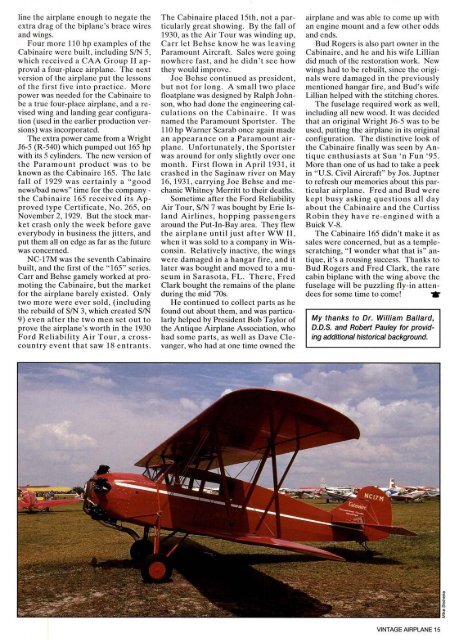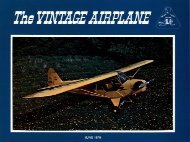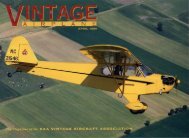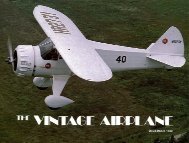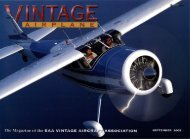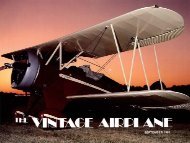VA Vol 23 No 8 Aug 1995 - Members Only
VA Vol 23 No 8 Aug 1995 - Members Only
VA Vol 23 No 8 Aug 1995 - Members Only
You also want an ePaper? Increase the reach of your titles
YUMPU automatically turns print PDFs into web optimized ePapers that Google loves.
line the airplane enough to negate the<br />
extra drag of the biplane's brace wires<br />
and wings.<br />
Four more 110 hp examples of the<br />
Cabinaire were built, including SIN 5,<br />
which received a CAA Group II approval<br />
a four-place airplane. The next<br />
version of the airplane put the lessons<br />
of the first five into practice. More<br />
power was needed for the Cabinaire to<br />
be a true four-place airplane, and a revised<br />
wing and landing gear configuration<br />
(used in the earlier production versions)<br />
was incorporated.<br />
The extra power came from a Wright<br />
J6-5 (R-540) which pumped out 165 hp<br />
with its 5 cylinders. The new version of<br />
the Paramount product was to be<br />
known as the Cabinaire 165. The late<br />
fall of 1929 was certainly a "good<br />
newslbad news" time for the company <br />
the Cabinaire 165 received its Approved<br />
type Certificate, <strong>No</strong>. 265, on<br />
<strong>No</strong>vember 2,1929. But the stock market<br />
crash only the week before gave<br />
everybody in business the jitters, and<br />
put them all on edge as far as the future<br />
was concerned.<br />
NC-17M was the seventh Cabinaire<br />
built, and the first of the "165" series.<br />
Carr and Behse gamely worked at promoting<br />
the Cabinaire, but the market<br />
for the airplane barely existed. <strong>Only</strong><br />
two more were ever sold, (including<br />
the rebuild of SIN 3, which created SIN<br />
9) even after the two men set out to<br />
prove the airplane's worth in the 1930<br />
Ford Reliability Air Tour, a crosscountry<br />
event that saw 18 entrants.<br />
The Cabinaire placed 15th, not a particularly<br />
great showing. By the fall of<br />
1930, as the Air Tour was winding up,<br />
Carr let Behse know he was leaving<br />
Paramount Aircraft. Sales were going<br />
nowhere fast, and he didn't see how<br />
they would improve.<br />
Joe Behse continued as president,<br />
but not for long. A small two place<br />
floatplane was designed by Ralph Johnson,<br />
who had done the engineering calculations<br />
on the Cabinaire. It was<br />
named the Paramount Sportster. The<br />
110 hp Warner Scarab once again made<br />
an appearance on a Paramount airplane.<br />
Unfortunately, the Sportster<br />
was around for only slightly over one<br />
month. First flown in April 1931, it<br />
crashed in the Saginaw river on May<br />
16,1931, carrying Joe Behse and mechanic<br />
Whitney Merritt to their deaths.<br />
Sometime after the Ford Reliability<br />
Air Tour, SIN 7 was bought by Erie Island<br />
Airlines, hopping passengers<br />
around the Put-In-Bay area. They flew<br />
the airplane until just after WW II,<br />
when it was sold to a company in Wisconsin.<br />
Relatively inactive, the wings<br />
were damaged in a hangar fire, and it<br />
later was bought and moved to a museum<br />
in Sarasota, FL. There, Fred<br />
Clark bought the remains of the plane<br />
during the mid '70s.<br />
He continued to collect parts as he<br />
found out about them, and was particularly<br />
helped by President Bob Taylor of<br />
the Antique Airplane Association, who<br />
had some parts, as well as Dave Clevanger,<br />
who had at one time owned the<br />
airplane and was able to come up with<br />
an engine mount and a few other odds<br />
and ends. '<br />
Bud Rogers is also part owner in the<br />
Cabinaire, and he and his wife Lillian<br />
did much of the restoration work. New<br />
wings had to be rebuilt, since the originals<br />
were damaged in the previously<br />
mentioned hangar fire, and Bud's wife<br />
Lillian helped with the stitching chores.<br />
The fuselage required work as well,<br />
including all new wood. It was decided<br />
that an original Wright J6-5 was to be<br />
used, putting the airplane in its original<br />
configuration. The distinctive look of<br />
the Cabinaire finally was seen by Antique<br />
enthusiasts at Sun 'n Fun '95.<br />
More than one of us had to take a peek<br />
in "U.S. Civil Aircraft" by Jos. Juptner<br />
to refresh our memories about this particular<br />
airplane. Fred and Bud were<br />
kept busy asking questions all day<br />
about the Cabinaire and the Curtiss<br />
Robin they have re-engined with a<br />
Buick V-8.<br />
The Cabinaire 165 didn't make it as<br />
sales were concerned, but as a templescratching,<br />
"I wonder what that is" antique,<br />
it's a rousing success. Thanks to<br />
Bud Rogers and Fred Clark, the rare<br />
cabin biplane with the wing above the<br />
fuselage will be puzzling fly-in attendees<br />
for some time to come! *<br />
My thanks to Dr. William Ballard,<br />
D.D.S. and Robert Pauley for providing<br />
additional historical background.<br />
VINTAGE AIRPLANE 15


